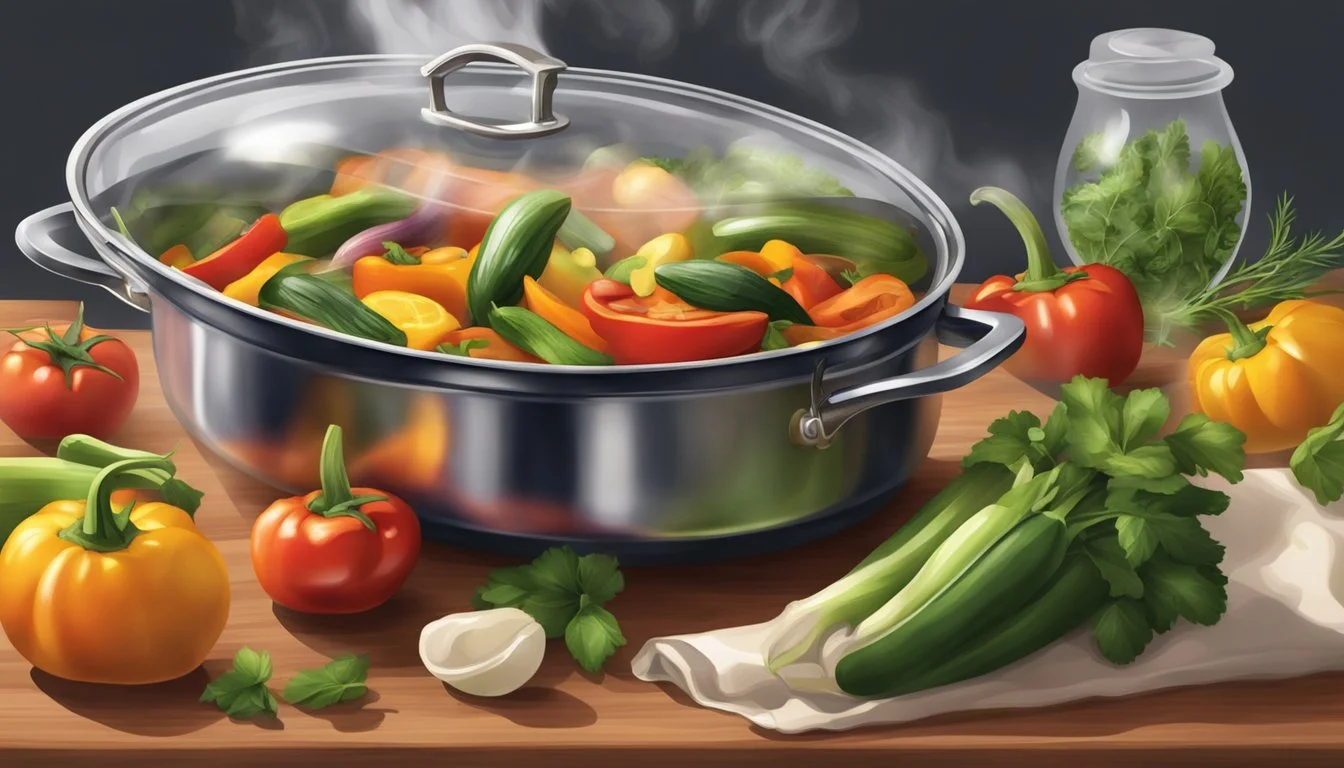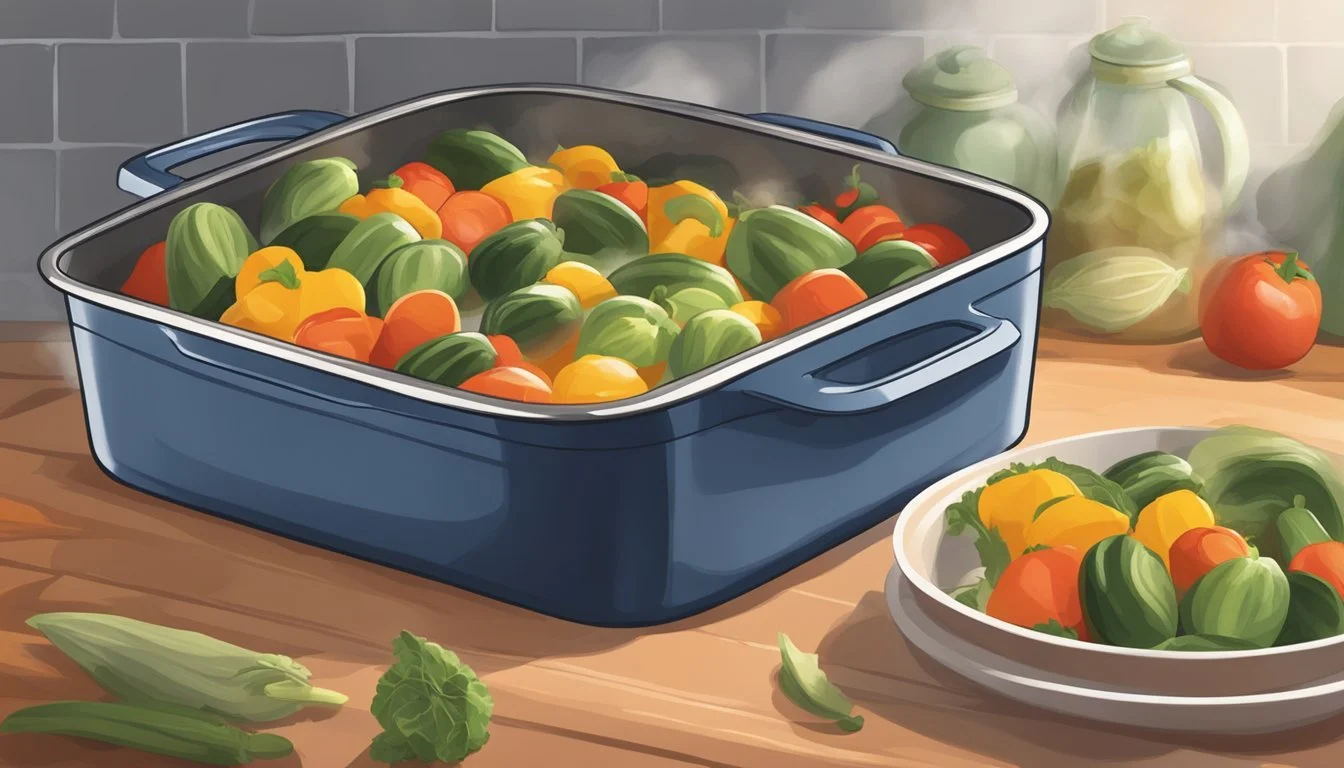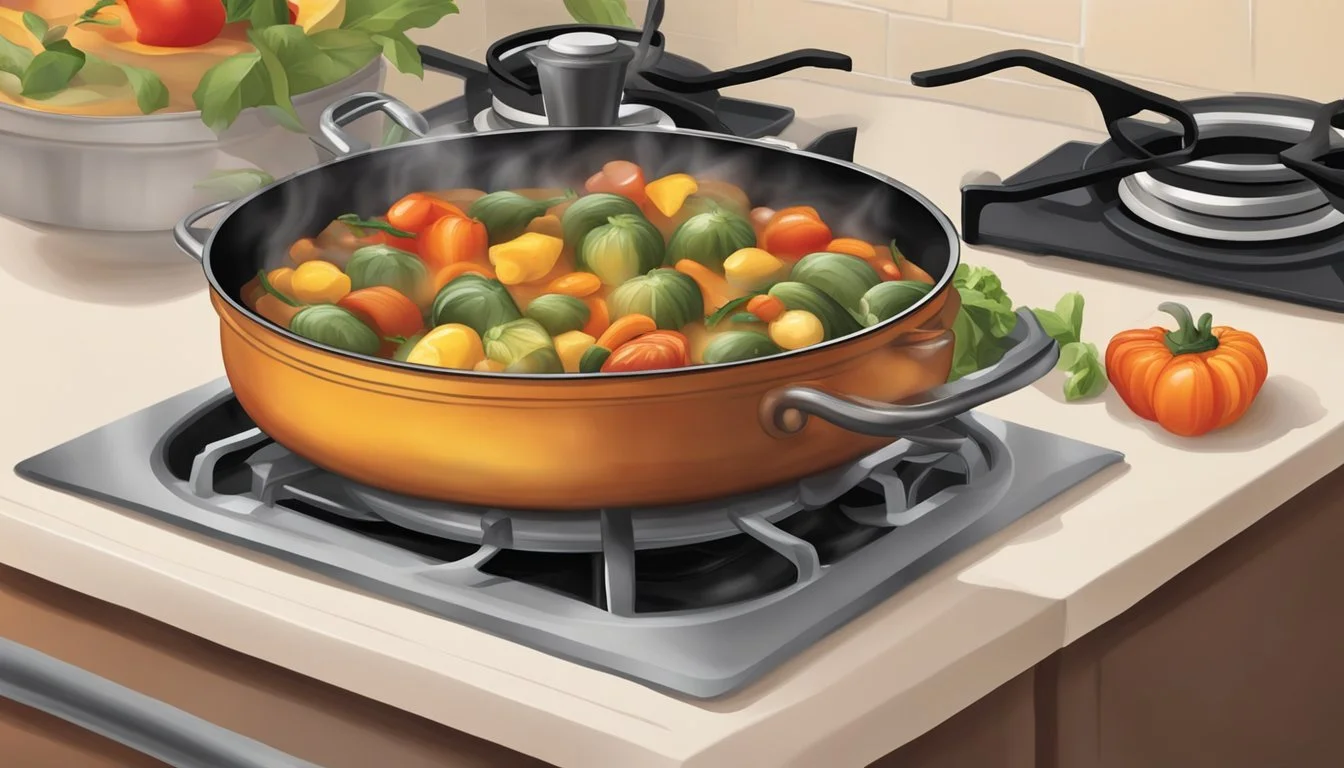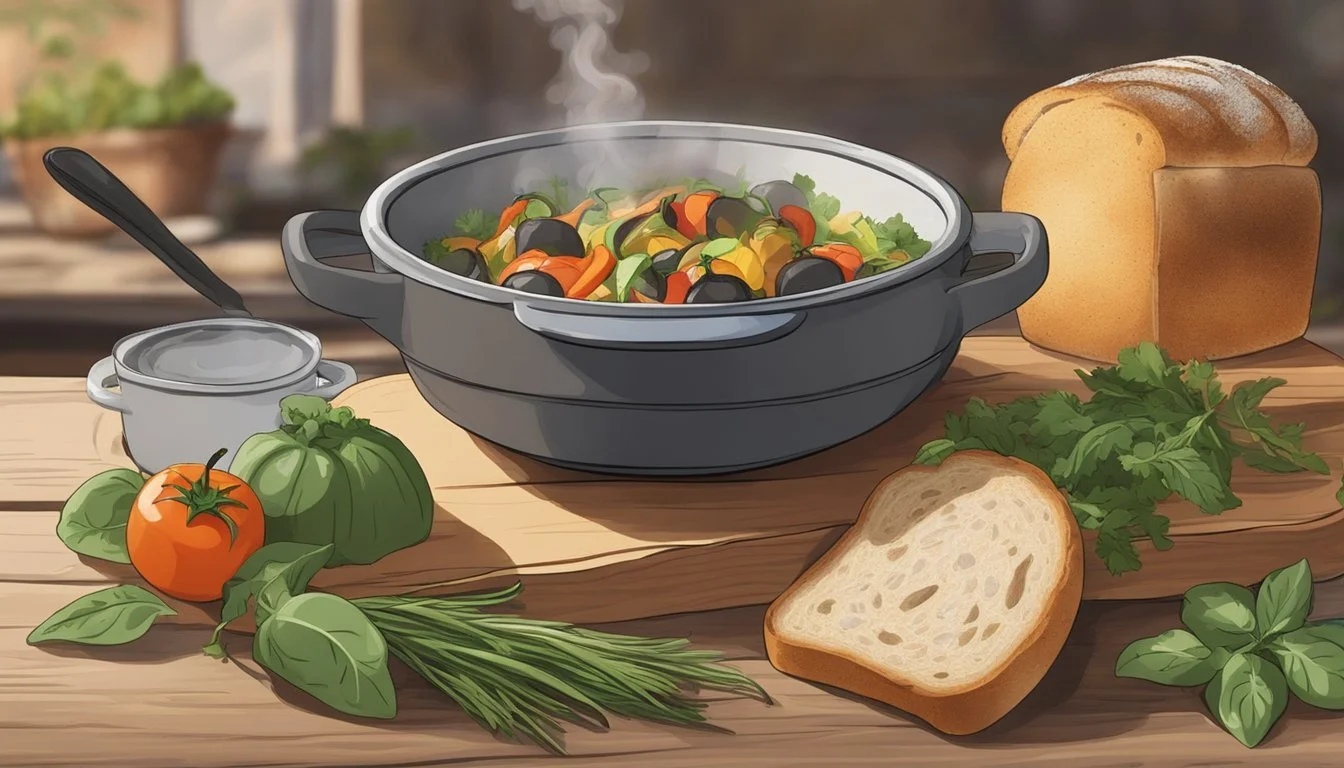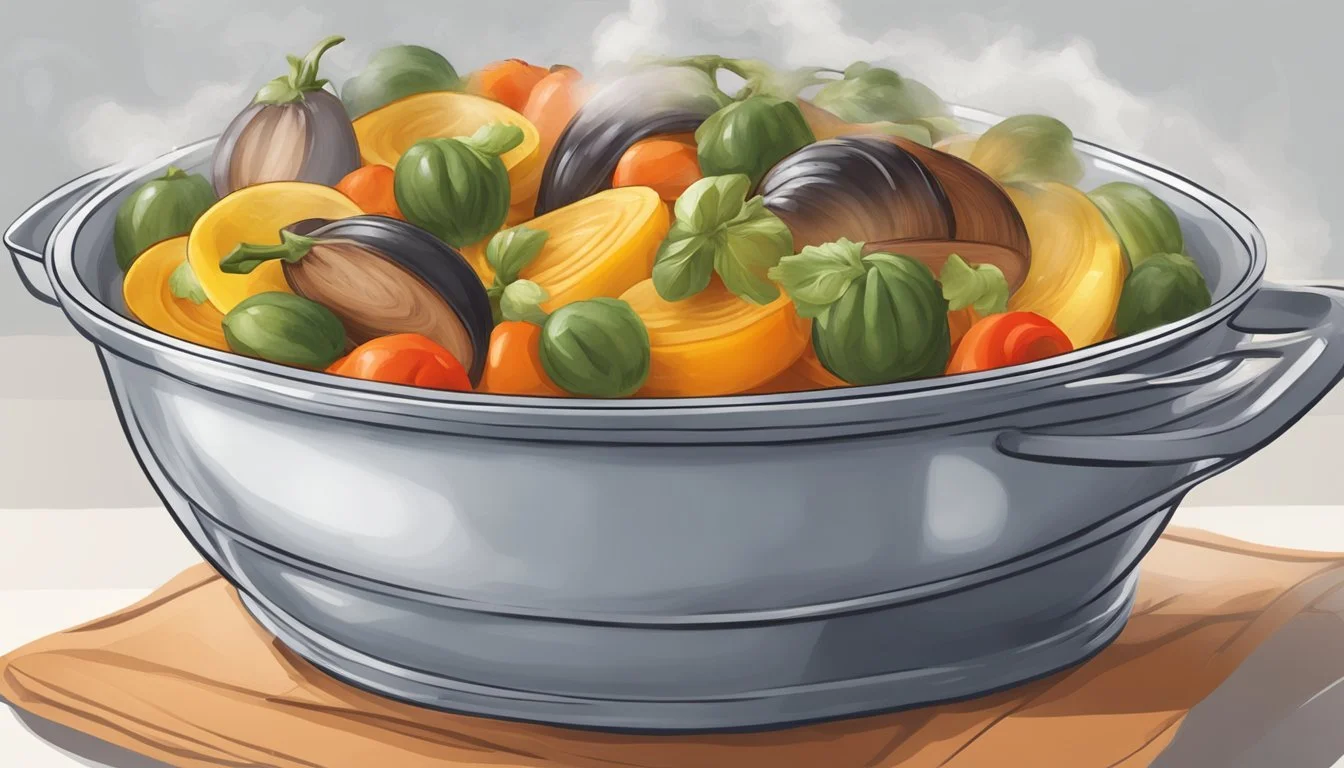Best Way to Reheat Ratatouille
Ensuring Tender Veggies and Rich Flavors
Ratatouille (What wine goes well with ratatouille?), a traditional French stewed vegetable dish, is celebrated for its vibrant flavors and medley of tender vegetables. Achieving the perfect balance of texture and taste requires a gentle touch, especially when reheating leftovers. The key to preserving the integrity of ratatouille lies in the method used to warm it up, as it can easily become overcooked, leading to mushy vegetables and a loss of individual flavors.
The process of reheating should be approached with the intention of gently warming the vegetables through while allowing the flavors to blend harmoniously. Techniques vary from oven-baking to simmering on the stovetop but each has the same goal: to revive the dish as close to its original state as possible. Careful attention to temperature and timing ensures that the vegetables remain tender, and the aromatic blend of herbs and spices that characterize ratatouille is enhanced rather than diminished.
Understanding Ratatouille
Ratatouille is a traditional French dish that elegantly combines a variety of vegetables and herbs. It is both a celebration of fresh produce and an example of how simple ingredients can create a symphony of flavors when cooked properly.
The Components of Ratatouille
The foundation of ratatouille includes several key vegetables:
Zucchini: Provides a tender texture and a slight sweetness when cooked.
Eggplant: Adds a creamy consistency and a rich, complex flavor.
Tomatoes: Act as a base for the stew, giving it a tangy and refreshing taste.
Bell Pepper: Offers a sweet and slightly bitter flavor that complements the other ingredients.
Onion and Garlic: Serve as aromatic bases, imbuing the dish with pungency and depth.
Olive Oil: Used to sauté and stew the vegetables, it enhances their flavors and adds a smooth, rich mouthfeel.
These elements are stewed together, allowing their flavors and textures to meld into a harmonious and rustic vegetable dish.
Flavor Profile and Seasonings
Ratatouille's flavor is characterized by the use of fresh herbs and seasoning to elevate the natural taste of the vegetables. Here are the key seasonings:
Salt and Pepper: Essential for bringing out the natural flavors of the ingredients.
Thyme: Adds a subtle, earthy undertone that pairs well with the other components.
Basil: Its sweet and peppery flavor complements the acidity of tomatoes and enriches the overall taste.
The delicate balance of these seasonings is crucial for achieving the quintessential ratatouille flavor profile that is at once hearty, aromatic, and comforting.
Storing Ratatouille
Proper storage techniques are crucial for maintaining the tenderness of vegetables and the complex flavor profile of ratatouille when having leftovers. Utilizing the right temperature settings and containers preserves the dish's quality.
Refrigeration Best Practices
For refrigerating ratatouille, the dish should be allowed to cool to room temperature before storage. One should transfer the ratatouille into an airtight container to prevent moisture loss and flavor absorption from other foods in the refrigerator. It's ideal to consume refrigerated ratatouille within 2-3 days to ensure its freshness and texture consistency.
Cool Down: Room temperature before refrigerating.
Transfer: Into an airtight container.
Consume: Ideally within 2-3 days for best quality.
Freezing and Thawing Ratatouille
Freezing ratatouille is feasible for long-term storage. Portion the leftovers into suitable container sizes, ensuring as little air as possible is left inside to prevent freezer burn. Label containers with the date before placing them in the freezer. To thaw, it's recommended to transfer the ratatouille to the refrigerator 24 hours before intended use for a slow and even temperature rise, ensuring the flavors remain intact and the vegetables' structure is not compromised.
Portion: Into desired sizes before freezing.
Air Removal: Minimize to prevent freezer burn.
Labeling: Mark with the date of freezing.
Thawing: In the refrigerator for 24 hours before use.
Reheating Fundamentals
When reheating ratatouille, maintaining the vegetable's tender texture and the dish's rich flavors are paramount. The method of reheating can greatly influence these outcomes.
Reheating for Optimal Texture
To achieve the best texture, preheating the oven to 300°F (150°C) is advisable. One should transfer the ratatouille into an oven-safe dish, and cover with foil to retain moisture. Timing is key: heat for about 15 minutes, but this may vary depending on portion size. For a stove-top alternative, a low to medium heat setting allows the ratatouille to simmer and remain tender. Stirring occasionally prevents sticking and assists in even heating.
Reheating to Preserve Flavors
Flavor preservation is best achieved by reheating slowly and gently. Using the oven ensures even distribution of heat and allows flavors to meld together harmoniously. It's optimal to stir the dish a few times during the process. If using a microwave, heat in short bursts, stirring in between, although this may not provide results as desirable as slower methods. Tasting the ratatouille during reheating and adjusting seasoning can help restore the full flavor profile.
Oven Reheating Technique
The oven reheating technique allows for a gentle, even heat that helps maintain the tenderness of the vegetables and keep the flavors intact in ratatouille.
Preparation Steps
Before reheating ratatouille in the oven, it is essential to preheat the oven to avoid prolonged exposure to heat, which can lead to overcooking. Covering the dish with foil is crucial to retain moisture and ensure that the vegetables do not dry out.
Preheat the oven to the recommended temperature.
Transfer ratatouille to an oven-safe dish.
Cover the dish with aluminum foil to lock in moisture.
Oven Times and Temperatures
The precision of oven times and temperatures is pivotal for achieving the desired warmth without compromising the texture and flavors of the ratatouille.
Preheat oven to 300°F (150°C).
Cook time: Heat the ratatouille for approximately 15 minutes. Check and stir occasionally to ensure even heating.
Oven Temperature Cook Time Notes 300°F (150°C) ~15 minutes Check and stir occasionally
Alternative Reheating Methods
Reheating ratatouille properly can preserve its flavors and keep the vegetables tender. Explore these alternative methods to achieve a warm, delicious dish without compromising its integrity.
Stovetop Reheating
For those looking to use the stovetop, one can maintain the tenderness of the vegetables and meld the flavors effectively. Steps for successful stovetop reheating:
Transfer ratatouille to a pan and add a splash of water or broth to prevent sticking.
Cover with a lid and reheat on a low to medium heat.
Stir occasionally, allowing the dish to simmer for about 10-15 minutes or until thoroughly warm.
Microwave Tips
Reheating ratatouille in a microwave can be simple and quick. Key points to remember for microwave use:
Place ratatouille in a microwave-safe dish, covering it with a microwave-safe lid or damp paper towel.
Heat in short, two-minute bursts, stirring between each interval to ensure even warming.
Continue until the ratatouille is hot, which typically takes around 4-6 minutes depending on the quantity.
Using a Grill
Warming ratatouille on a grill can add a subtle, smoky flavor. Here's how to do it safely:
Preheat the grill to a low setting.
Place the ratatouille in a grill-safe dish and cover it with aluminum foil to retain moisture.
Heat for about 10-15 minutes, stirring occasionally until it's nicely warmed through.
Serving Suggestions
When reheating ratatouille, serving it in the right way can enhance its flavors and textures. The following suggestions aim to complement the rich tapestry of tastes in a reheated ratatouille.
Accompaniments for Ratatouille
Ratatouille can be enjoyed either as a flavorful side or as a hearty main dish. The key is selecting accompaniments that harmonize with its robust Mediterranean profile.
As a Side Dish: Its rich texture complements grilled meats or roasted fish.
As a Main Dish: Serve with a side of pasta, rice, or polenta for a complete meal. Incorporating cheese, such as grated Parmesan or crumbled goat cheese, can add a savory depth.
For breakfast, consider serving reheated ratatouille with a frittata for a nutritious start to the day.
Presentation Tips
The presentation of ratatouille can greatly impact the dining experience. Here are some tips to make it visually appealing:
Use warm, preheated dishes to maintain the temperature of the ratatouille.
Garnish with fresh herbs like basil or thyme to add color and aroma.
Serve alongside a piece of crusty bread to soak up the flavorful juices.
Enhancing Ratatouille
To truly elevate the flavors and nutrition of ratatouille, incorporating proteins and integrating fresh elements can transform this classic dish. Specifically, adding varied proteins and fresh herbs can create a more rounded and satisfying meal.
Adding Proteins
Chicken: For non-vegetarian ratatouille, diced chicken breast adds a lean protein boost. Before reheating the ratatouille, one could pan-sear the chicken with a bit of olive oil until fully cooked and then mix it into the dish for a hearty variation.
Fish: Delicate white fish What wine goes well with white fish?) or salmon can be a great addition for those seeking a pescatarian option. Either bake or steam the fish separately and flake it over the ratatouille before serving.
For vegans or vegetarians, incorporating legumes such as lentils or chickpeas can offer a plant-based protein source, enhancing the dish's protein content without using animal products.
Integrating Fresh Elements
Fresh Basil: Adding freshly chopped basil over the reheated ratatouille can not only bring a burst of color but also enhance the fragrance and taste. Basil pairs well with the tomato base often found in ratatouille.
Fresh Herbs: Other fresh herbs like rosemary, thyme, or oregano can be stirred into ratatouille towards the end of the reheating process. They add complexity to the dish's flavor profile. Fresh herbs are preferable for their vibrancy and potency compared to their dried counterparts.
Nutritional Overview
Ratatouille is a vegetable stew that combines an array of colorful vegetables, each contributing to the dish’s nutritional profile. In this overview, the focus is specifically on the caloric content and the vitamins and minerals that ratatouille provides.
Caloric Content
Ratatouille is typically low in calories because its primary ingredients are vegetables. A standard serving contains approximately:
Calories: 90-200 kcal
Fat: 5-15 g
Saturated Fat: 1-3 g
Sodium: 300-800 mg
Potassium: 450-900 mg
Carbohydrates: 10-20 g
Fiber: 4-6 g
The caloric value can vary depending on the types and amounts of vegetables used, as well as additional ingredients like oil for sautéing.
Vitamins and Minerals
The vegetables in ratatouille, particularly tomatoes, eggplants, zucchinis, and bell peppers (What wine goes well with bell peppers?), are sources of several key vitamins and minerals:
Vitamin A: Essential for eye health; present mainly in red and yellow bell peppers.
Vitamin C: Helps with the repair of tissues; richly supplied by tomatoes and bell peppers.
Calcium: Important for bone health; smaller amounts found in the vegetables.
Iron: Crucial for blood health; trace amounts available from the plant-based ingredients.
Each vegetable adds to the overall nutritional value. For example, tomatoes are particularly high in vitamin C, while the skins of eggplants and zucchinis contribute to the fiber content.
Finalizing the Dish
Reheating ratatouille is more than just warming up; it's an opportunity to enhance its flavors. A careful balance of seasoning and thorough quality checks are crucial to elevate the dish.
Seasonal Adjustments
When finalizing the reheated ratatouille, one must account for seasonality and personal taste preferences. This is the ideal moment to add a pinch of sugar if the tomatoes are not at their peak sweetness or to brighten up the dish with a hint of black pepper or red pepper flakes for a subtle warmth. Keep the following considerations in mind:
Sugar: A small amount to counteract any acidity, especially if tomatoes are out of season.
Black Pepper: Freshly ground to invigorate the dish with piquancy.
Red Pepper Flakes: Sparingly used to introduce a delicate heat that does not overwhelm the vegetables.
Final Quality Checks
The chef should confirm that the vegetables retain their tenderness and that all flavors are well integrated. Here are some key aspects to verify for quality assurance:
Texture: Vegetables should be tender yet hold their shape.
Consistency: Ensure the ratatouille is neither too dry nor too soupy.
Seasoning: Taste and adjust; do not hesitate to correct the seasonings to ensure a flavorful, well-balanced dish.
A successful finalization means that the dish not only tastes nice but also presents a harmonious interplay of its components.
Creative Variations
Exploring the versatility of ratatouille opens up a world of culinary possibilities that go beyond reheating the classic dish. By adding new elements or combining different cuisines, one can transform ratatouille into a novel experience while maintaining the essence of its tender vegetables and harmonious flavors.
Ratatouille-Inspired Dishes
Transforming ratatouille into a casserole can enhance its flavors and textures, perfect for a comforting meal. Simply layer the reheated ratatouille with slices of yellow squash and potatoes, top with breadcrumbs and dots of goat cheese, and bake until golden.
For a lighter variation, one might serve the leftover ratatouille atop a bed of quinoa, an excellent way to integrate a nutty, protein-rich grain with the savory vegetable stew.
Mixing in Different Cuisines
Incorporating elements from different culinary traditions can breathe new life into ratatouille. Adding oregano, a dash of tomato sauce, and serving over a toasted french bread can give it an Italian twist. It creates an appetizing ratatouille bruschetta that is both hearty and flavorful.
One could also use a baking sheet to oven-roast the reheated ratatouille until slightly crispy. This method introduces a delightful texture that pairs well with Greek-inspired spices and herbs, infusing a Mediterranean flair into the dish.
Preventive Measures
Properly reheating ratatouille can ensure vegetables remain tender and flavors stay melded. This section will outline steps to avoid common errors and secure a perfectly warmed dish.
Avoiding Common Mistakes
Storing the Ratatouille: Always store leftover ratatouille in an airtight container to keep it fresh and prevent the vegetables from becoming mushy.
Seasoning Adjustments: Upon reheating, the balance of flavors may change. It may be necessary to add a pinch of garlic powder, dried thyme, or dried oregano to enhance the taste without overpowering the traditional ratatouille essence.
Preserving Texture:
Sauté Carefully: If one chooses to reheat by sautéing, heat should be kept moderate to prevent leftover vegetables from becoming too soft or burn. Stir gently to avoid breaking the vegetables down into a melty state.
Cooling: Before refrigerating, let the ratatouille come to room temperature to avoid condensation inside the container, which can make the dish soggy.
Ensuring Perfect Reheat Every Time
Oven Reheating: Preheat the oven to a low temperature, such as 300°F, cover the dish with foil, and heat for about 10-15 minutes. Checking and stirring occasionally helps even out the temperature.
Stovetop Method: Gently reheat the ratatouille in a covered pan over low to medium heat for 10-15 minutes. One could add a small amount of water if it appears dry, and incorporating chopped yellow onion can refresh the flavors.
Key Temperatures and Times:
Reheat to at least 165°F, checking with a food thermometer to ensure safety.
If stored in the refrigerator, consume the reheated ratatouille within four to five days to maintain quality and safety.
By following these recommendations, ratatouille can retain its savory flavors and tender textures when reheated.



